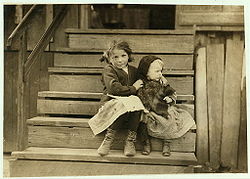Sister
 From Wikipedia - Reading time: 7 min
From Wikipedia - Reading time: 7 min



A sister is a woman or a girl who shares parents or a parent with another individual; a female sibling.[1] The male counterpart is a brother. Although the term typically refers to a familial relationship, it is sometimes used endearingly to refer to non-familial relationships.[2] A full sister is a first-degree relative.
Overview
[edit]The English word sister comes from Old Norse systir which itself derives from Proto-Germanic *swestēr, both of which have the same meaning, i.e. sister. Some studies have found that sisters display more traits indicating jealousy around their siblings than their male counterparts, brothers.[3] In some cultures, sisters are afforded a role of being under the protection by male siblings, especially older brothers, from issues ranging from bullies or sexual advances by womanizers.[4] In some quarters, the term sister has gradually broadened its colloquial meaning to include individuals stipulating kinship.[5] In response, in order to avoid equivocation, some publishers prefer the usage of female sibling over sister.[6] Males with a twin sister sometimes view her as their female alter ego, or what they would have been like if they had two X chromosomes.[7] A study in Perth, Australia found that girls having only younger brothers resulted in a chastity effect: losing their virginity on average more than a year later than average. This has been hypothesized as being attributed to the pheromones in their brothers' sweat and household-related errands.[8]
Sororal relationships
[edit]Various studies have shown that older sisters are likely to give a varied gender role to their younger siblings, as well as being more likely to develop a close bond with their younger siblings.[9] Older sisters are more likely to play with their younger siblings.[10] Younger siblings display more needy behavior when near their older sister[11] and are more likely to be tolerant of an older sister's bad behavior.[12] Boys with only one older sister are more likely to display stereotypically male behavior, and such masculine boys increased their masculine behavior with the more sisters they have.[13] The reverse is true for young boys with several sisters, as they tend to be feminine, however, they outgrow this by the time they approach pubescence.[14] Boys with older sisters were less likely to be delinquent or have emotional and behavioral disorders.[15] A younger sister is less likely to be scolded by older siblings than a younger brother.[16] The most common recreational activity between older brother/younger sister pairs is art drawing.[9] Some studies also found a correlation between having an older sister and constructive discussions about safe sexual practices.[17] Some studies have shown that men without sisters are more likely to be ineffectual at courtship and romantic relationships.[18]


See also
[edit]References
[edit]- ^ "Definition of sister in English". Oxford Dictionaries. Archived from the original on May 24, 2019. Retrieved 2019-05-24.
- ^ Mufwene, Salikoko S. "The pragmatics of kinship terms in Kituba." (1988): 441–454.
- ^ Volling, B. L.; McElwain, N.L.; Miller, A.L. (2002). "Emotion Regulation in Context: The Jealousy Complex between Young Siblings and its Relations with Child and Family Characteristics". Child Development 73 (2): 581–600.
- ^ Handbook of Cultural Psychiatry — Page 67, Wen-Shing Tseng – 2001
- ^ van der Burghe, Pierre (1987). The Ethnic Phenomenon. p. 27.
- ^ Olshewsky, Thomas (1969). Problems in the philosophy of language. p. 286.
- ^ McCallum, Robyn. "Other Selves: subjectivity and the doppelganger in Australian adolescent fiction. Example of the sister in a sentence "The sisters live in the convent at Lafayette Towers." Writing the Australian child: Texts and contexts in fictions for children (1996): 17–36.
- ^ Pincott, Jena E (March 20, 2011). "Do Brothers Stall Their Sisters' Sex Lives?". Psychology Today. Archived from the original on 18 Jan 2023.
- ^ a b Gender — Page 53, Leanne Franklin – 2012
- ^ Play from Birth to Twelve: Contexts, Perspectives, and Meanings, Doris Bergen 2015
- ^ Sisters and Brothers — Page 78, Judy Dunn – 1985
- ^ The Corsini Encyclopedia of Psychology and Behavioral Science, Volume 4, Charles B. Nemeroff, 2002 p 1524
- ^ Gender Development — Page 300, Lynn S. Liben – 2009
- ^ Gender Development, Sheri A. Berenbaum, 2013
- ^ Advances in Child Development and Behavior, Volume 26, p 161, 1996
- ^ He & she: how children develop their sex role identity, Wendy Schempp Matthews – 1979 p 162
- ^ Handbook of Adolescent Psychology, Contextual Influences on Adolescent Development, Laurence Steinberg, PhD – 2009 p 61
- ^ Leventhal, Gerald S. "Influence of brothers and sisters on sex-role behavior." Journal of Personality and Social Psychology 16.3 (1970): 452.
External links
[edit] The dictionary definition of sister at Wiktionary
The dictionary definition of sister at Wiktionary
 KSF
KSF